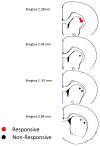Representation of the body in the lateral striatum of the freely moving rat: Fast Spiking Interneurons respond to stimulation of individual body parts
- PMID: 27914882
- PMCID: PMC5303163
- DOI: 10.1016/j.brainres.2016.11.033
Representation of the body in the lateral striatum of the freely moving rat: Fast Spiking Interneurons respond to stimulation of individual body parts
Abstract
Numerous studies have shown that certain types of striatal interneurons play a crucial role in selection and regulation of striatal output. Striatal Fast-Spiking Interneurons (FSIs) are parvalbumin positive, GABAergic interneurons that constitute less than 1% of the total striatal population. It is becoming increasingly evident that these sparsely distributed neurons exert a strong inhibitory effect on Medium Spiny projection Neurons (MSNs). MSNs in lateral striatum receive direct synaptic input from regions of cortex representing discrete body parts, and show phasic increases in activity during touch or movement of specific body parts. In the present study, we sought to determine whether lateral striatal FSIs identified by their electrophysiological properties, i.e., short-duration spike and fast firing rate (FR), display body part sensitivity similar to that exhibited by MSNs. During video recorded somatosensorimotor exams, each individual body part was stimulated and responses of single neurons were observed and quantified. Individual FSIs displayed patterns of activity related selectively to stimulation of a discrete body part. Most patterns of activity were similar to those exhibited by typical MSNs, but some phasic decreases were observed. These results serve as evidence that some striatal FSIs process information related to discrete body parts and participate in sensorimotor processing by striatal networks that contribute to motor output.
Statement of significance: Parvalbumin positive, striatal FSIs are hypothesized to play an important role in behavior by inhibiting MSNs. We asked a fundamental question regarding information processed during behavior by FSIs: whether FSIs, which preferentially occupy the sensorimotor portion of the striatum, process activity of discrete body parts. Our finding that they do, in a selective manner similar to MSNs, begins to reveal the types of phasic signals that FSI feed forward to projection neurons during striatal processing of cortical input regarding a specific sensorimotor event. These findings suggest new avenues for testing feed-forward inhibition theory as applied to striatum in naturalistic conditions, such as whether FSI decreases facilitate excitation of MSNs related to the current movement while FSI increases silence MSNs unrelated to the current movement.
Keywords: Dorsolateral striatum; Electrophysiology; Fast Spiking Interneurons; Parvalbumin.
Copyright © 2016 Elsevier B.V. All rights reserved.
Conflict of interest statement
The authors declare no competing financial interests.
Figures





Similar articles
-
Feedforward inhibition of projection neurons by fast-spiking GABA interneurons in the rat striatum in vivo.J Neurosci. 2005 Apr 13;25(15):3857-69. doi: 10.1523/JNEUROSCI.5027-04.2005. J Neurosci. 2005. PMID: 15829638 Free PMC article.
-
Selective activation of striatal fast-spiking interneurons during choice execution.Neuron. 2010 Aug 12;67(3):466-79. doi: 10.1016/j.neuron.2010.06.034. Neuron. 2010. PMID: 20696383 Free PMC article.
-
Synchronized firing of fast-spiking interneurons is critical to maintain balanced firing between direct and indirect pathway neurons of the striatum.J Neurophysiol. 2014 Feb;111(4):836-48. doi: 10.1152/jn.00382.2013. Epub 2013 Dec 4. J Neurophysiol. 2014. PMID: 24304860 Free PMC article.
-
Dopamine-modulated dynamic cell assemblies generated by the GABAergic striatal microcircuit.Neural Netw. 2009 Oct;22(8):1174-88. doi: 10.1016/j.neunet.2009.07.018. Epub 2009 Jul 19. Neural Netw. 2009. PMID: 19646846 Review.
-
Excitatory extrinsic afferents to striatal interneurons and interactions with striatal microcircuitry.Eur J Neurosci. 2019 Mar;49(5):593-603. doi: 10.1111/ejn.13881. Epub 2018 Mar 25. Eur J Neurosci. 2019. PMID: 29480942 Free PMC article. Review.
Cited by
-
Continuous Representations of Speed by Striatal Medium Spiny Neurons.J Neurosci. 2020 Feb 19;40(8):1679-1688. doi: 10.1523/JNEUROSCI.1407-19.2020. Epub 2020 Jan 17. J Neurosci. 2020. PMID: 31953369 Free PMC article.
-
Local or Not Local: Investigating the Nature of Striatal Theta Oscillations in Behaving Rats.eNeuro. 2017 Sep 13;4(5):ENEURO.0128-17.2017. doi: 10.1523/ENEURO.0128-17.2017. eCollection 2017 Sep-Oct. eNeuro. 2017. PMID: 28966971 Free PMC article.
-
Striatal function scrutinized through the PAN-TAN-FSI triumvirate.Front Cell Neurosci. 2025 Mar 25;19:1572657. doi: 10.3389/fncel.2025.1572657. eCollection 2025. Front Cell Neurosci. 2025. PMID: 40201383 Free PMC article. Review.
-
Homogeneous processing in the striatal direct and indirect pathways: single body part sensitive type IIb neurons may express either dopamine receptor D1 or D2.Eur J Neurosci. 2017 Oct;46(8):2380-2391. doi: 10.1111/ejn.13690. Epub 2017 Oct 4. Eur J Neurosci. 2017. PMID: 28887882 Free PMC article.
-
Sensory representations in the striatum provide a temporal reference for learning and executing motor habits.Nat Commun. 2019 Sep 9;10(1):4074. doi: 10.1038/s41467-019-12075-y. Nat Commun. 2019. PMID: 31501436 Free PMC article.
References
-
- Alexander GE, Delong MR. Microstimulation of the primate neostriatum. II. Somatotopic organization of striatal microexcitable zones and their relation to neuronal response properties. J Neurophysiol. 1985;53:1417–1430. - PubMed
-
- Bennett BD, Bolam JP. Synaptic input and output of parvalbuminimmunoreactive neurons in the neostriatum of the rat. Neurosci. 1994;62:707–719. - PubMed
-
- Berke JD, Okatan M, Skurski J, Eichenbaum HB. Oscillatory entrainment of striatal neurons in freely moving rats. Neuron. 2004;43(6):883–896. - PubMed
Publication types
MeSH terms
Substances
Grants and funding
LinkOut - more resources
Full Text Sources
Other Literature Sources
Research Materials

